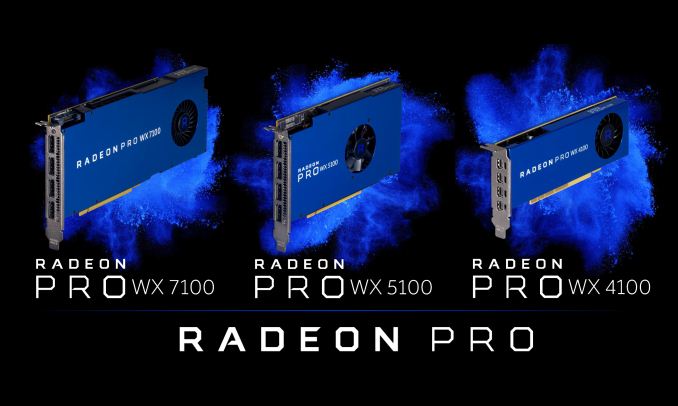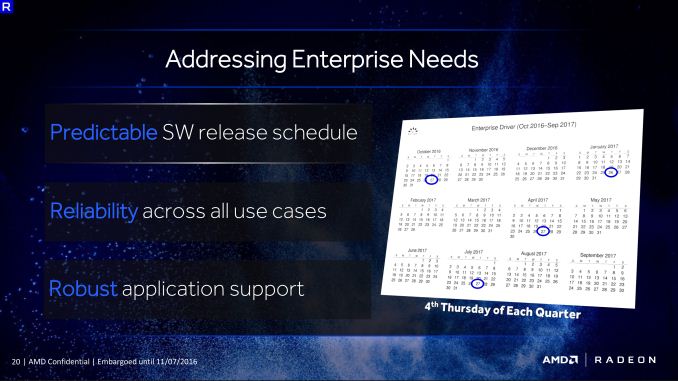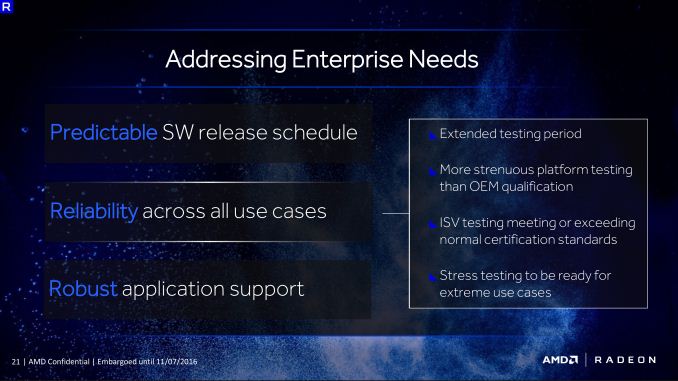Now Shipping: AMD Radeon Pro WX Series
by Ryan Smith on November 7, 2016 9:00 AM EST- Posted in
- GPUs
- AMD
- Polaris
- Radeon Pro

Back in July AMD announced the Radeon Pro WX series. Part of a broader rebranding effort for AMD’s professional grade graphics cards – moving away from the FirePro brand and making everything part of the Radeon family – the WX series would also mark the first use of AMD’s latest-generation Polaris architecture in their pro cards. At the time of their announcement, AMD had not finalized the card specifications or launch date beyond Q4, but as of this week the cards are finally reaching AMD’s partners and retailers, and the final specifications are being released.
| AMD Workstation Video Card Specification Comparison | ||||||
| WX 7100 | W7100 | WX 5100 | WX 4100 | |||
| Stream Processors | 2304 | 1792 | 1792 | 1024 | ||
| Texture Units | 144 | 112 | 112 | 64 | ||
| ROPs | 32 | 32 | 32 | 16 | ||
| Boost Clock | ~1.24GHz | 920MHz | ~1.09GHz | ~1.17GHz | ||
| Memory Clock | ? | 5Gbps GDDR5 | ? | ? | ||
| Memory Bus Width | 256-bit | 256-bit | 256-bit | 128-bit | ||
| VRAM | 8GB | 8GB | 8GB | 4GB | ||
| TBP | 130W | 150W | 75W | 50W | ||
| Width | Single | Single | Single | Single | ||
| GPU | Polaris 10 | Tonga | Polaris 10 | Polaris 11 | ||
| Architecture | Polaris | GCN 1.2 | Polaris | Polaris | ||
| Manufacturing Process | GloFo 14nm | TSMC 28nm | GloFo 14nm | GloFo 14nm | ||
| Launch Date | 11/10/2016 | 08/2014 | 11/18/2016 | 11/10/2016 | ||
| Launch Price (MSRP) | $799 | N/A | $499 | $399 | ||
When AMD first announced these cards, they were targeting better than 2 TFLOPS, 4 TFLOPS, and 5 TFLOPS for the WX 4100, WX 5100, and WX 7100 respectively. The final specifications put the WX 7100 and WX 4100 ahead of that, at 5.7 and 2.4 TFLOPS. However the WX 5100 ended up coming up a bit short of AMD’s goal; it tops out at 3.9 TFLOPS.
Otherwise the cards have not significantly changed since AMD’s initial unveiling. Though along with the final specifications, we also have the final TBPs. The top-tier WX 7100 is rated for 130W, while the WX 5100 becomes AMD’s pro card of choice for 75W systems that don’t offer an external power connection. Finally the low-end WX 4100 is being rated at 50W. Meanwhile AMD is going for a single-wide cards across the entire family, something they also did with the 150W-and-below members of the previous-generation FirePro series.
Finally, when it comes to pricing AMD indicated that they’d continue to be very competitive with NVIDIA here, and the final prices reflect that. The WX 7100 will be hitting the market at $799, with the WX 5100 and WX 4100 bringing up the rear at $499 and $399 respectively. AMD has over the last couple of generations aimed to offer better performance-per-dollar than NVIDIA in this space, and the Radeon Pro WX series is continuing this tradition. The high-end WX 7100 and low-end WX 4100 will be available later this week on the 10th, while the mid-range WX 5100 will hit the virtual shelves later next week on the 18th.
Driver News: Quarterly Releases for Pro Drivers
Along with this week’s launch of the Radeon Pro WX series cards, AMD is also further clarifying their plans for software support of the new hardware. Even with the change in branding, the Radeon Pro WX series is still getting its own, separate enterprise driver release.
The biggest shift here is that AMD is now going to be releasing drivers on a set schedule; they will be releasing drivers quarterly, on the fourth Thursday of each quarter. In fact this new schedule is being applied to all AMD pro cards, including their existing FirePro cards, with their most recent driver release on October 27th (driver 16.Q4) serving as the first release under this schedule. AMD hopes that by offering drivers on a fixed release schedule, they can strike a balance between updates and stability for pro users, giving pro users regular updates while avoiding the disarray that can come from unexpected driver releases.
AMD is also reiterating their focus on reliability and driver quality. Besides getting drivers certified by the usual parties in the pro application space – Autodesk, Adobe, Dassault Systèmes, etc – they are also doing their own internal testing, the idea being to exceed what their OEM partners are already doing. From a market share perspective AMD is still the underdog by a significant margin, so it's important they show potential customers that they can meet or beat NVIDIA on support and reliability, as well as performance.



















32 Comments
View All Comments
psychobriggsy - Monday, November 7, 2016 - link
I'm sure that the $799 price helps with utilising more expensive but more compact cooling solutions.BrokenCrayons - Monday, November 7, 2016 - link
Maybe so, but once the cost of developing a single slot cooler is absorbed (which is most certainly the case already as there are single slot cooled cards that are shipping out the door today..and were previously as well) then there's no longer an engineering cost barrier. That leaves us with material and manufacturing costs. Material costs are probably lower since there's less metal on a single slot cooler by weight. Milling, maching, and that sort of thing might play a role too, but probably not as much as you might think if these coolers were in mass production.I think the bottom line is consumer perceptions wouldn't be met for the majority of the target market. That market consists largely of causal tinkerers and less educated buyers that use Walmart logic when they look at PC parts, assuming automatically that a larger, heavier thing must be better at the same job regardless of the actual product performance. (Walmart logic is a term derived from a study supposedly conducted by the aforementioned retail chain that pitted identical desktop computers against one another, one in a smaller and lighter case and the other in a larger and heavier one. Despite performance being identical due to the identical parts, Walmart shoppers reportedly cited the larger and heavier computer as being the faster of the two.) Consequently, GPU manufacturers use dual slot coolers to appease consumers. I think that factor alone rises up above any cost concerns.
MrSpadge - Monday, November 7, 2016 - link
You're right in that these smaller coolers are very likely cheaper than bigger dual slot coolers with heat pipes.> Consequently, GPU manufacturers use dual slot coolers to appease consumers.
Yes, but acoustically and not optically. check out reviews of existing single slot coolers for cards at ~75 W. They should be available. The cards will be a bit older, but the design is still pretty much the same. You'll find their acoustics "acceptable" if you want single slot cooler so badly, whereas others would consider a card "clearly audible" unacceptable. Now imagine twice the heat output.. you'd need more than 2 times the fan speed to cool that with the same cooler to the same temperature. Fan noise and power consumption rise worse than quadratically with fan speed (due to turbulent flow). They probably also increase the maximum temperature to ~90°C, which helps with cooling but again increases power consumption.
My quick search found a review of a FirePro W8100:
http://www.tomshardware.de/firepro-w8100-workstati...
It's got a somewhat higher power consumption of 188 W tamed by a double slow blower style cooler. It's almost hitting 90°C and its noise characterized as "under load still somewhat bearable". Now take half of that fan and heat sink away...
xenol - Thursday, November 10, 2016 - link
Because the AIBs need to feel good about themselves for designing an overkill cooling solution.Seriously, did MSI have to make a Gaming X version of the GTX 1060 that's basically the exact same mechanically as the GTX 1080?
bug77 - Monday, November 7, 2016 - link
"AMD has over the last couple of generations aimed to offer better Windows_performance-per-dollar than NVIDIA in this space..."FTFY, because AMD is still a tough sell on Linux.
WinterCharm - Monday, November 7, 2016 - link
Yeah. Linux support on AMD cards is abysmal :(coder543 - Monday, November 7, 2016 - link
I've seen a lot of people getting excited about AMD on Linux recently because of how much better AMDGPU and AMDGPU-PRO are than their predecessors.bug77 - Tuesday, November 8, 2016 - link
They're not when it comes to OpenGL. The OpenGL part has just been ported over, it's just as crappy.TheinsanegamerN - Monday, November 7, 2016 - link
So they can sell a full P11 die at 50 watt in single slot, but no OEMs can sell me a 460 in single slot at 75 watt?I smell shenanigans.
tarqsharq - Monday, November 7, 2016 - link
Cherry picked dies. That's part of the reason that one costs $400 and the gaming variants cost less than a third of that.